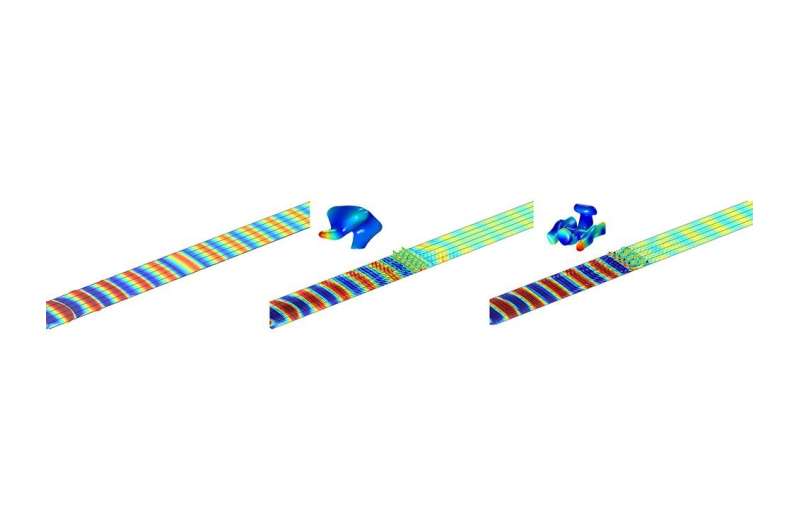
Surface waves from earthquakes, explosions and other human activity can propagate out from an epicenter, wreaking havoc as they go. Controlling such waves could prevent damage and destruction. At much smaller scales, surface wave filtering and manipulation could induce desirable properties in miniature electronic devices.
Now, Penn State College of Engineering researchers have used a strategic design approach called the topology optimization method (TOM) to design fabricated, patterned sheets with tunable properties—called metasurfaces—that control surface waves. Led by Parisa Shokouhi, professor of engineering science and mechanics, the team published their results in JASA Express Letters.
“Our multidisciplinary team designed a metasurface barrier made up of resonating—or vibrating—structures to stop plate waves from propagating into a specific area,” Shokouhi said.
Surface waves are long-range and can travel far without losing much energy, but the metasurface barrier’s resonating structures can interrupt them.
“Control of guided waves has applications across length scales from surface acoustic wave devices—used in electronics and non-destructive evaluation and structural health monitoring, such as inspecting pipelines—to seismic barriers,” Shokouhi said.
The resonating structures in this barrier are tuned to a specific frequency, matching the predefined target frequency of surface waves propagating across an aluminum plate. According to Shokouhi, the researchers formulated their design methodology as a topology optimization problem, using TOM. Aimed at generating a bandgap—a zone without propagation—around a specific frequency, the topology optimization method automatically designs resonators that are optimally shaped to have certain resonance and antiresonance characteristics. This results in what Shokouhi called locally resonant elastodynamic metasurfaces.
“In this paper, we demonstrate that the methodology can design resonators for metasurfaces capable of suppressing plate waves, called Lamb waves, but this method can be extended to design resonant metasurfaces that can control other types of guided waves regardless of the frequency range,” Shokouhi said, noting it is the first time TOM—initially designed in the 1980s to solve structural design problems—has been applied in this way. “This systematic design strategy can be generalized further, presenting a potential approach for wave control in other areas, such as acoustics.”
More information:
Daniel Giraldo Guzman et al, Design of resonant elastodynamic metasurfaces to control S0 Lamb waves using topology optimization, JASA Express Letters (2022). DOI: 10.1121/10.0015123
Citation:
Engineers design metasurfaces to help control surface wave propagation (2023, March 2)
retrieved 2 March 2023
from https://techxplore.com/news/2023-03-metasurfaces-surface-propagation.html
This document is subject to copyright. Apart from any fair dealing for the purpose of private study or research, no
part may be reproduced without the written permission. The content is provided for information purposes only.
For all the latest Technology News Click Here
For the latest news and updates, follow us on Google News.

